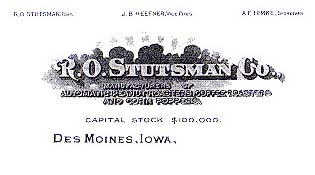
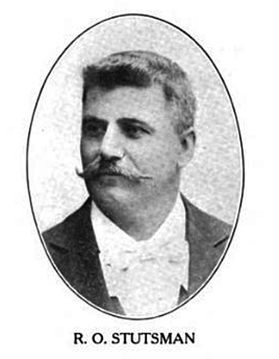
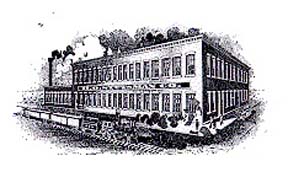
| R.O. Stutsman Co. |
 |
 |
 |
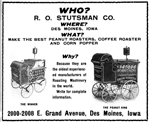 |
 |
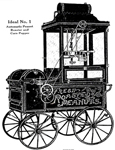 |
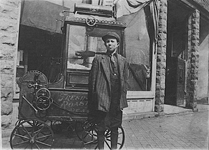 |
 |
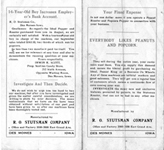 |
The above photos are links to larger copies of company items from the R. O. Stutsman over 100 years ago. |
| A Peanut Wagon From: "....Deep In the Heart Of Texas" |
|
R.O.Stutsman Co,"Ideal #1," |
Before you can restore a popcorn wagon, you have to locate one that needs restoration. That being said the fact is, nearly all vintage popcorn wagons (the ones that were used) need restoration. By their nature and history, the antique popcorn wagon brings together several factors that make these wonderful wagons a mess. These factors are: Grease, Salt, Water and Age. "Grease" rots wood, and many popcorn wagons have a framework of wood. "Salt & Water" foster and feed oxidation, (rust.) Finally, the "Passage of Time" makes the destruction nearly complete. |
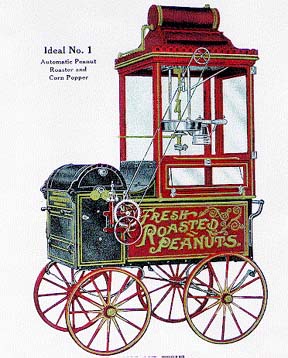 |
This R.O.Stutsman, "Ideal #1" (ca.1916), was found in its original state at the "Wagon Masters Antiques" in O'Fallon Mo. When it was found and purchased, it was bought for its patterns and castings. Nearly all of the wood and most of the sheet metal was rotted into an unstable condition. The cast iron parts however, were all, for the most part in very good re-useable condition. The exceptions were, the spring barrel, which had been damaged and was poorly repaired, and the various bronze governor gears and parts, which had simply worn away threw use. The spring barrel had to be made totally new of cast iron. All of the rest of the cast parts were cleaned, medal prepped, then repainted. (Note the exposed Peanut Roster in the last image.) One of the major problems with this machines castings was the fact that they were all covered in several thick layers of lead-based enamel paint. Today we know, food and Lead simply do not mix. |
The only other example of this builders wagon, (that I could find) was located at The Wyandotte Popcorn Museum, in Marion, OH. Museum President & Historical Researcher, George K. Brown allowed for a very special tour and photo session of the museum and gave full access to their "R.O.Stutsman Ideal #1." A very special "Thanks" George and the Wyandotte Popcorn Museum. |
|
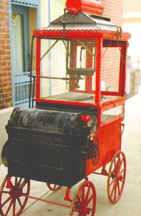 |
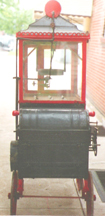 |
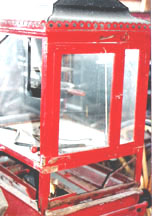 |
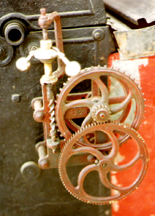 |
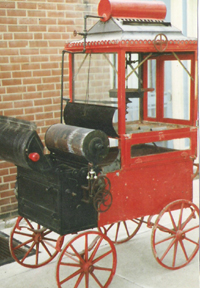 |
This series of images show the Stutsman Popcorn Wagon as it was found, dirt and all. The Stutsman I purchased worked but had many problems that had to be addressed. The first part of any restoration is the research of the item being restored. Research was carried out at the Wyandotte Popcorn Museum. In seeing and photographing their "Ideal #1." It was realized that this wagon was very complete, but it did not match the Wyandotte's restored wagon. Other than color, the peanut pan and the popcorn bin were both different. Between the two wagons this Stutsman (having never been touched) seemed to be the one that was truer to the company's 1916 design. The restored Wyandotte wagon had been remade into someone's idea of a Stutsman Ideal #1. Both machines had many of the same numbered parts, When the "Wagon Master" machine was taken apart and the parts were blasted a complete list of part numbers were assembled. I checking the Wyandotte machine it was found that both were numbered the same way. So, drawings were made from the parts as they were taken off of the wagon. New pieces were fabricated to mimic the vintage parts of this machine and all of the parts were put aside until they would be needed at reassembly. |
|
| R.O.Stutsman Co,"Ideal #1," In the 1957 Movie "Payton Place" |
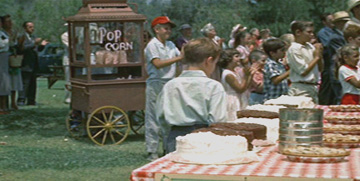 |
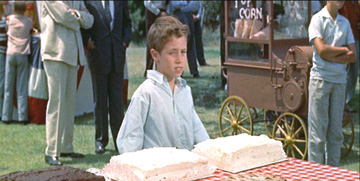 |
Movies have way of transporting us to other times and places. Many times, items on the scene simply flash by with little notice, but their impact is registered in the viewer. Different times and places have their special things that help us relate to them. "Tie-Dye & Headscarfs"-1960s. "Poodle Skirts & Leather Jackets"-1950s. What respectable 1940s picnic would be complete without a popcorn wagon? Having spent a lot of time working on my wagon, I was stunned to see this R. O. Stutsman (Ideal #1) Popcorn Wagon as it was passing by in a current viewing of the 1957 movie, "Payton Place." Even though this wagon does not have vintage colors or signage it was a sight for sore eyes. What a great way to confirm pipe configurations. |
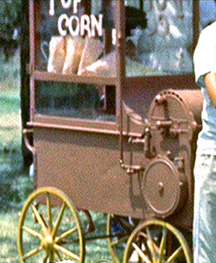 |
| Many, Many Parts |
 |
| This long image displays a six foot "Studio" table full of the many Stutsman part that resulted from disassembly of the wagon. After it was taken apart and the parts were stripped to remove the lead paint and sand blasted to condition their surfaces. These pieces were then metal conditioned and painted before re-assembly. |
 |
| Major Damage / New Barrel Castings |
Sometime during the many years of this
wagon's working life, it suffered a catastrophic spring failure. |
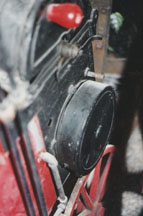 |
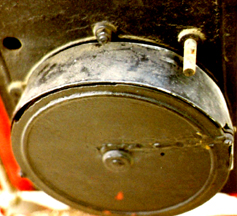 |
 |
 |
The Ideal #1 was operated by turing a winding crank to tighten a 1/16"thick x 2"wide x 30 foot long coiled spring. It was located inside of an 8" diameter spring barrel. The power of a spring of this size produces is tremendous amount of raw energy. At sometime in the wagons past life, this main spring broke. The explosive power of this releasing spring, exploded nearly half of the side-wall of the springs outer barrel and nearly cracked the cover of the spring barrel in half. To repair this damaged, and to get the wagon working again, a sheet-metal patch was fabricated and bolted in place on the barrel's outer rim and the barrel cover had been brazed. When the barrel and it's screw-on cover were cleaned and checked, it was plain to see that these two parts would be un-usable in a "proper" restoration. A Birch Ply-wood patterns was built for both parts and they were taken to a local foundry where they were cast. (To identify these parts as new, they were marked and dated before they were cast.) The new parts were machined and assembled as replacements with great results. In order to limit this kind of destruction from happening again, a new spring was also made to replace the one that had been broken and had been brazed back together. |
| New Wood |
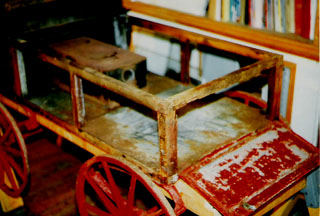 |
The Foundation of the entire popcorn wagon rests on the wooden wagon framework. The actual wagon frame was in rotten shape. All of the support pieces were remade in ash (as were their patterns.) These new parts were then reassembled just as they were in 1916 with nails. |
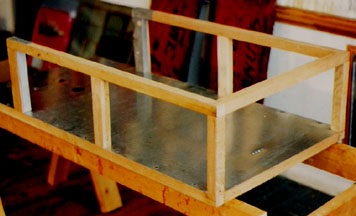 |
| Sheet Metal Skin |
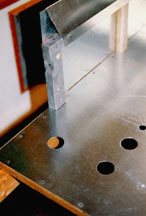 |
This wooden framework was then covered with a new skin of 18 gage galvanized sheet metal. All parts were all put in place using galvanized roofing nails as was the vintage wagon. Also like the 1916 wagon the nail heads were soldered in place as Stutsman had. |
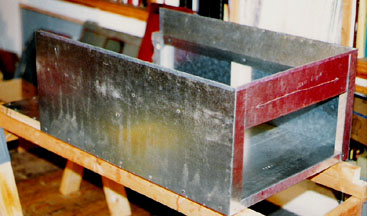 |
| The last stop for the wagon assembly was the auto body shop where it was painted red inside and out. | 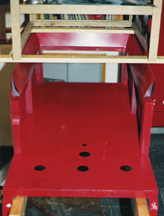 |
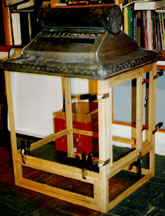 |
In these two images can be seen the new oak Popper housing. The Vintage frame work was dissambled and dupilicated exactly from the patters of the old frame. |
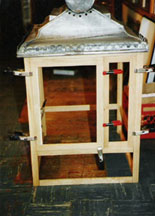 |
|
| Vintage Sign-age |
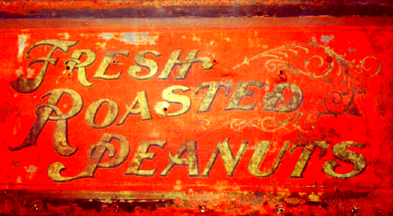 |
One of the most exciting finds of the restoration was the discovery of the original wagon sign-age. When the wagon sides rusted through and became ugly, they were simply recovered with new galvanized sheet metaland painted,( In this case Red). The wagon was then pressed back into service. |
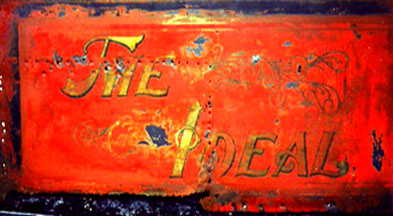 |
When the wagon was taken apart, the 1916 wagon sides were found pretty much intact under the later addition. There was a coat of paint over the signs, (this was removed,) but they were very helpful in laying out and painting the new cart sides with the vintage look. |
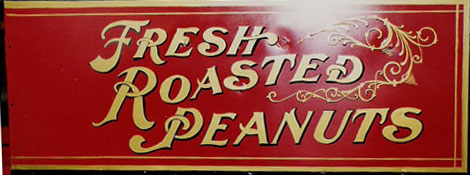 |
|
|
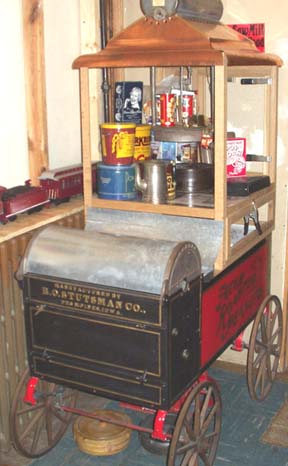 |
If you are a popcorn collector and are heading in the Toleado Ohio area don't miss the J.H. Fentress Antique Popcorn Museum. They specialize in Holcomb & Hoke Popcorn machines and offers Tours of the museum By appointmentd. |
|
Holcomb & Hoke Popcorn Machines Click this Icon to visit The J.H. Fentress Antique Popcorn Museum on their Web site |
(Rev.02-2010)